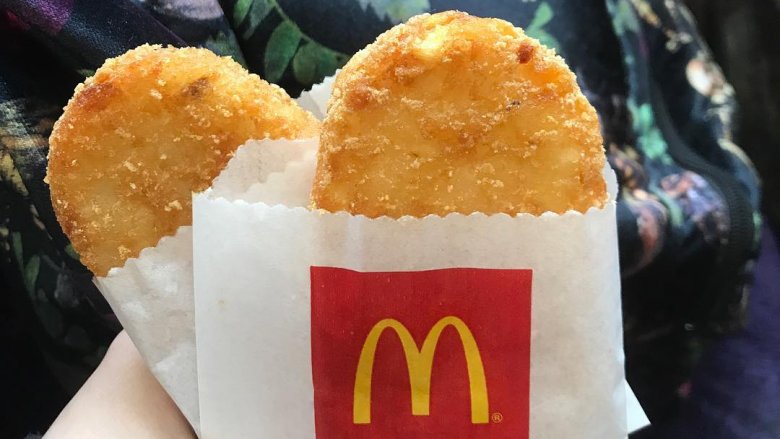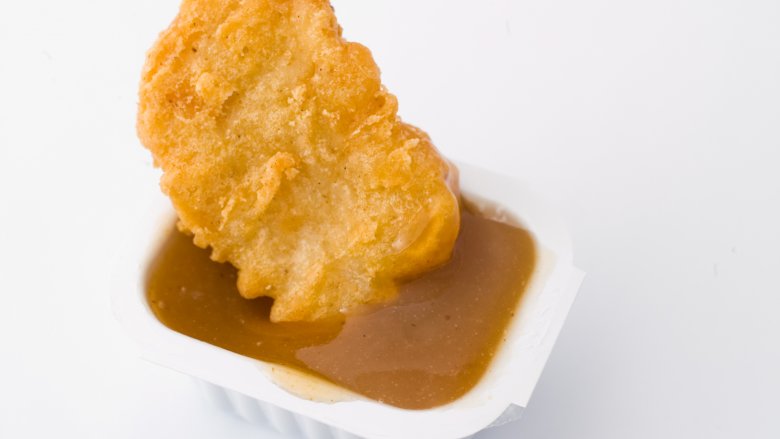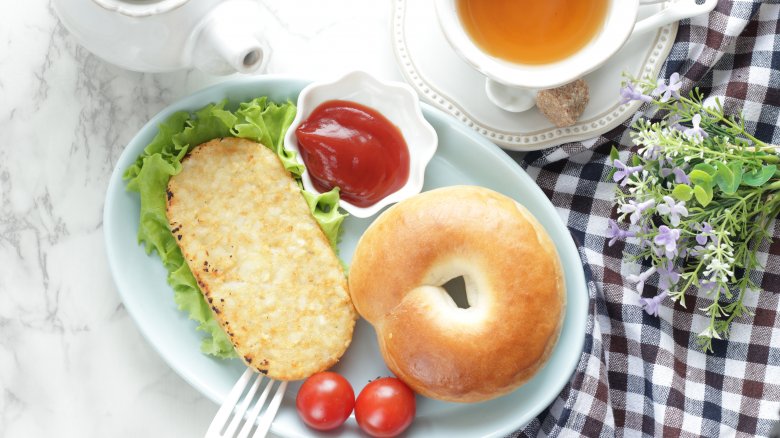The Truth About McDonald's Famous Hash Browns
Here at Mashed, we're not driven by conjecture, rumor, or half-baked ideas. Bound by our commitment to the pursuit of fact, we're ready to draw the following ironclad, not-at-all-controversial conclusion: McDonald's Hash Browns are probably the finest product ever to grace a fast food drive-thru window.
Whether you rawdog them with a little extra salt, cover them in a smooth blanket of ketchup, tuck them into a breakfast sandwich, or spread grape jelly on them like some kind of monster, McDonald's hash browns never fail to disappoint. Whether you eat them in celebration of shaving a few minutes off your best half-marathon time, or eat them to recover from drinking more tequila than any human being ever has in history, the McDonald's hash brown is as close as we're likely to come to quick-service food perfection. Golden brown, crunchy on the outside, soft and greasy on the inside, with flakes of cooked potato that seem to be bound together by pure magic, we'd choose a couple of paper sleeves full of hash browns over a stale order of fries every single time.
But even if you already love McDonald's hash browns, you have to ask yourself: How well do you really KNOW them, and how able are you to annoy friends at parties by reciting unsolicited facts about this legendary foodstuff? Read on, for the truth about McDonald's famous hash browns.
They first arrived on the menu in 1977
In 1969, the McDonald's corporation had barely begun to realize its full potential and integrate itself into the fabric of our lives by placing one restaurant every 7/10ths of a mile. That's because in the late '60s, the restaurant only served lunch and dinner items; inexpensive hamburgers and milkshakes were the company's major claim to fame.
That all began to change in 1970, when franchisee Jim Delligatti first received permission from the big boys at corporate to begin selling donuts and sweet rolls during breakfast hours. The seemingly simple idea was enough to get the brass at the Golden Arches wondering about the viability of a breakfast menu, and they began testing the Egg McMuffin, originally conceived as a sort of "Eggs Benedict On-the-Go," in 1971.
Fast forward to 1977, and boom: McDonald's goes after customers' breakfast dining dollars HARD, with the nationwide rollout of a full breakfast menu that includes the well-received Egg McMuffin, along with hotcakes, English muffins, sausage, Danish, and yes... the now-infamous hash brown. Within ten years, McDonald's would go on to achieve a statistical milestone, serving one out of every four breakfasts eaten outside of the home. The rest is breakfast fast food history.
They can substantially improve any sandwich
McDonald's breakfast sandwiches, from the Egg White Delight to the Triple Breakfast Stack Sausage McGriddle, are as close to portable breakfast perfection as mankind has been able to achieve thus far. But what if we told you there was a way to make your breakfast sandwich even BETTER, to escalate it to previously unheard-of levels of high-calorie deliciousness?
Look, we're not going to call this a "hack," because that's a term that should be reserved for actual, y'know, hacking, like when you want to change your grades, or when you want to access an unreleased computer game and accidentally end up playing tic-tac-toe with a government supercomputer to teach it valuable life lessons about the futility of triggering Global Thermonuclear War. (UGH, how good was WarGames, you guys?)
No, this isn't so much a "hack," as it is "doing something unorthodox with your breakfast," which is a very different thing. Here's the highly technical, step-by-step guide: 1. Order the McMuffin of your choice. 2. Remove top layer of English muffin or biscuit. 3. Slip that hash brown right inside, and replace the lid. 4. Enjoy your new and improved breakfast sandwich, complete with new levels of crunch, greasiness, and deliciousness.
They don't have a ton of weirdo ingredients
We don't typically turn to McDonald's, when we want to avoid eating food with lots of strange laboratory-grade ingredients. The chain includes tons of preservatives, flavoring agents, coloring and stabilizers in their food that simply aren't a part of your home kitchen (though, we'll admit, they've gotten better in recent years).
When it comes to weirdo ingredients that may someday be linked to your children being born with gills, McDonald's hash browns are actually one of the chains least-adulterated menu options. The humble hash browns contain just eight ingredients, and they're (mostly) the things you'd expect: Potatoes, oil, salt, flour, black pepper.
Compare that with the McFrankenstein creation that is, say, the chain's signature "Mac" sauce, and the ingredients will start to seem downright wholesome. It's just ketchup and mayonnaise, right? You wouldn't think that something as simple as "burger sauce" could clock in with so many ingredients, but the corporate chefs at McDonald's have managed it. Mac sauce is loaded with oddball ingredients that you might not expect, including preservatives, coloring, and plenty of high fructose corn syrup... and that's before you've even built the rest of your burger.
They're causing a bit of an issue now that McDonald's serves breakfast all day
It's a bit of a given that you can now order most of the McDonald's breakfast menu at any time of day, but life wasn't always so perfect. After years of requests, the restaurant didn't roll out the potential for 2 p.m. McMuffins until 2015, and the transition in some locations was rocky, at best.
The limited fryer real estate at some locations meant that many restaurants couldn't cook hash browns while keeping upwith the public's seemingly relentless demand for french fries. McDonald's locations had to scramble to upgrade their equipment, even as McDonald's denied that a problem existed in the first place. A representative for McDonald's told Business Insider that "despite rumors to the contrary that are spreading on social media," actually 90 percent of locations were serving all-day hash browns, and the others could add hash browns at any time.
A few years later, and most McDonald's locations seem to have ironed out the kinks... but before you assume you're going to be able to knock out a couple of orders of hash browns at 9 o'clock at night, you'd better ask.
They can be ordered well-done
Here's a fact that REALLY nearly broke the internet, Kim Kardashian's big fake champagne-covered butt notwithstanding: McDonald's hash browns, like french fries, can be ordered well-done.
Turns out, with a simple request for "well done" hash browns at the drive-thru (and maybe a "please" and a "thank you," you heathens), the venerable hash brown can be transformed from a sad, pale, insipid mass of oily wet potato into the golden brown, crunchy potato patty of your most fevered fantasies.
An extra minute or two in the fryer is all takes to send those hash browns into the salty stratosphere, creating a picture-perfect rendition of the classic side dish that's crunchy and craggy on the outside, while staying impossibly soft and fluffy on the inside, with a gorgeous golden brown exterior. It makes for an instant upgrade for that otherwise uninspiring breakfast McGriddle combo. And of course, thanks to McDonald's All-Day Breakfast, perfectly crispy hash browns can even be served alongside your regular burger order, in place of french fries. Our only question is: Why aren't the hash browns already cooked this way by default?
There's beef flavoring in the fry oil
You've probably noticed how weirdly addictive McDonald's french fries and hash browns are. We get it: Served piping hot and fresh, that unique combination of "salty" and "fried" can be nearly impossible to resist. But it turns out there's another secret ingredient that makes fries and hash browns difficult to eat just a few at a time, and that, friends, is beef flavoring.
Wait, why on God's green Earth would McDonald's be adding beef flavoring, of all things, to an otherwise vegetarian product like hash browns and french fries? The tradition can be traced back to the 1950s, when the company that supplied fry oil to McDonald's couldn't afford the equipment necessary to hydrogenate the oil, so they began shipping a frying blend that was a blend of vegetable oil and beef tallow.
Fast forward to the 1980s, when health enthusiasts clad (presumably) in Day-Glo spandex tights and leg warmers started making a fuss about how ridiculously unhealthy frying potatoes in cow fat was, and the company reverted to a pure vegetable oil blend... but kept that faint suçon of meaty barnyard funk by adding natural beef flavoring to their fryers. Just like that, an addictive classic was born.
They don't cure hangovers, but they don't NOT cure hangovers
As you've no doubt realized by now, we're not doctors. Okay, we've got that one intern whose parents think she's in school studying to be an anesthesiologist instead of writing about hot dogs on the internet, but we don't want to blow up her spot. The point is, we're in no way qualified to be dispensing anything remotely resembling medical advice. So let's leave it at this: McDonald's Hash Browns aren't going to undo the damage you caused to your swollen brain by drinking 13 Stoli-Raz-and-sodas last night. But they aren't NOT going to help, either.
Contrary to what the internet may have led you to believe, greasy or fried foods are not going to help your body "soak up the alcohol." That's just not the way alcohol metabolization works, and even if it were, grease isn't water-soluble. If eating a big plate of fried stuff makes you feel a little better after a hangover, it probably has more to do with the carbohydrate load of what you're eating, which is easy for the body to digest, and probably what your body needs most after raging for eight straight hours on a blend of rocket-grade ethylene and pure adrenaline. You're probably getting some electrolyte-replenishing benefit from all the salt, as well... but certainly not enough to "cure" a hangover.
They're a poor substitute for McNuggets
FACT: McDonald's Hash Browns are not McDonald's Chicken McNuggets. Need proof? When a drunk Australian weaved his way through a drive through in Sydney at 4:50 a.m. to try and sober up with a ten-piece, he was told that, unlike breakfast, McNuggets aren't available all day, and particularly before sunup. The man flew into an inebriated rage, demanding "200 orders of hash browns" instead, then began circling the parking lot while he waited for his order. When the police inevitably showed up, it was... not a good scene. According to a report on the Metro website, officers breathalyzed the still-wobbling suspect, and found that he was operating at over three times the legal blood alcohol limit. Whoops.
Drunk or sober, it just goes to show you: When a man needs his McNuggets, a hash brown (or even 200 hash browns) are a poor substitute.
They're not even super terrible for you
If you're counting calories and fat grams, the McDonald's menu can be a potential diet-busting minefield. While there are some (sort of) healthy options available, it's easy to talk yourself into why it's perfectly reasonable to order a Double Quarter Pounder with Cheese and an order of fries and a Coke, which will provide about the total amount of calories that most adults should eat in a whole day.
Think you're making a more responsible nutritional choice with a salad? The Southwest Buttermilk Crispy Chicken salad clocks in at 520 calories and 25 grams of fat, which is about the same as a Big Mac.
Instead, consider the humble hash brown: 150 calories, and a paltry-by-comparison 9 grams of fat. Heck, with those numbers, you can eat two with a cup of black coffee or a diet soda and still have a snack that satisfies your cravings for deep fried grease and fat, at lower numbers than most of the rest of the menu.
They can land you in court
Because our day-to-day lives aren't already fraught with peril, and because law enforcement clearly has no bigger fish to fry, eating a McDonald's Hash Brown while operating a motor vehicle could land you in court. Yes, seriously.
In 2018, Connecticut motorist Jason Stiber was pulled over for talking on a cell phone while operating a motor vehicle, landing him a $300 ticket for "distracted driving." Sounds like a common story, in areas where there is no actual crime to fight, right? There was just one problem: Stiber maintains that he wasn't talking on a cell phone; he was happily macking a McDonald's hash brown.
We know, we know... a likely story, right? Stiber is fighting the citation in court, and it turns out he's got some evidence to back up his claims. His cell phone records allegedly show no calls placed from Stiber's cell phone around the time of the infraction. The lesson? If you're going to eat a McDonald's hash brown while whipping three tons of steel around at high speeds, do it discretely, and try to avoid holding your hash brown up to your ear at any point, no matter how badly you want it to whisper its secrets.
They're not gluten free
Have you adopted a gluten-free lifestyle, either due to being legitimately diagnosed with celiac disease, or because you crave scientifically baseless special attention during everyday service-oriented transactions? No matter the cause of your gluten aversion, we've got some unfortunate news for you: McDonald's hash browns are NOT a gluten-free food.
Potatoes? A little oil? What could go wrong, right? But listed right there on the ingredient panel is a big, all-caps warning: "CONTAINS WHEAT AND MILK." Though the hash browns are coated in corn flour for crunchiness, the wheat and milk addition (or "contamination," depending on your point of view) is probably linked to the "Natural Beef Flavor" that's added to the mix. Those avoiding gluten also need to be concerned with cross-contamination in the fryer oil, since the same fryers are used for both hash browns and McDonald's french fries, another item spiked with wheat and milk. Sorry, celiac sufferers.











